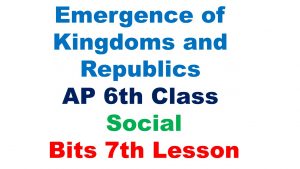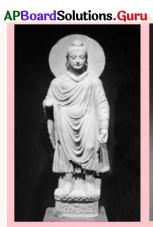
Emergence of Kingdoms and Republics Bit Bank – Here complete bit bank for all exams from Emergence of Kingdoms and Republics Class 6 Social Studies lesson 7.
Question 1.
The Ashwamedha was the sacrifice of the
A) Horse
B) Cow
C) Goat
D) Elephant
Answer:
A) Horse
Question 2.
One-sixth of the produce was taken as tax from
A) Farmers
B) Craftspersons
C) Traders
D) Village headmen
Answer:
A) Farmers
Question 3.
People began settling down along the river banks, in large numbers some -years ago.
A) 280
B) 3700
C) 2700
D) 3000
Answer:
C) 2700
Question 4.
…………… made tools necessary for agriculture.
A) Goldsmith
B) Blacksmith
C) Craftsmen
D) Village headmen
Answer:
B) Blacksmith
Question 5.
The Vajji Mahajanapada was to the …………. of Magadha.
A) North
B) South
C) West
D) East
Answer:
A) North
Question 6.
The largest plain region in North India.
A) Ganga- Indus plain
B) Jhelum – Sutlez plains
C) Ghaggar plain
D) Sutlez-Indus Plain
Answer:
A) Ganga- Indus plain
Question 7.
The rivers that flow between the Himalayas and the peninsular plateau
A) Mahanadi
B) Jhelum – Sindhu
C) Ganga-Yamuna
D) Yamun-Sindu
Answer:
C) Ganga-Yamuna
Question 8.
The sellers in the beginning of the Ganga – Indus plain were
A) Traders
B) Agriculturists
C) Craftsmen
D) Rajans
Answer:
B) Agriculturists
Question 9.
Tribes that settled in the beginning days were
A) Janapadas
B) Grihapatis
C) Kings
D) Gond Patla
Answer:
A) Janapadas
Question 10.
Performing agriculture with metal tools was done in the period of
A) Janapadas
B) Nomads
C) Mahajanapadas
D) Agriculturists
Answer:
C) Mahajanapadas
Question 11.
The landowners of the Mahajanapadas period were called
A) Grihapatis
B) Gahapatis
C) Bhuswami
D) Traders
Answer:
A) Grihapatis
Question 12.
The war prisoners were sold to farmers.
A) Dasulu
B) Bhartukas
C) Prisioners
D) Craftsmen
Answer:
A) Dasulu
Question 13.
The primary income source to the state in Mahajanapada period.
A) Taxes
B) Business people
C) Soldiers
D) Traders
Answer:
A) Taxes
Question 14.
Agriculturists shared 1/6th of the crop to the king. What this share is called ?
A) Bhaga
B) Thula
C) Bali
D) Share
Answer:
A) Bhaga
Question 15.
The mineral found in the southern region of Magadha kingdom
A) Iron
B) Gold
C) Copper
D) Bronze
Answer:
A) Iron
Question 16.
Archaelogists have excavated hundreds of sites in
A) Egypt
B) Indus valley
C) Ganges valley
D) Mesopotomia
Answer:
C) Ganges valley
Question 17.
Magadha kingdom spread over on the both sides of which river?
A) Yamuna
B) Ganga
C) Brahmaputra
D) Godavari
Answer:
B) Ganga
Question 18.
Vajji had its capital city at
A) Raj agriha
B) Vaishali
C) Magadha
D) Gondwana
Answer:
B) Vaishali
Question 19.
Which janapada is in South India?
A) Asmaka
B) Magadha
C) Kosala
D) Vashali
Answer:
A) Asmaka
Question 20.
Ramayana was written by
A) Vyasa maharshi
B) Rama
C) Valmiki
D) Vyasa
Answer:
C) Valmiki
Question 21.
Mahabharata was written by
A) Vyasa Maharshi
B) Krishna
C) Valmiki
D) Vemana
Answer:
A) Vyasa Maharshi
Question 22.
Mahabharata narrates the story of
A) Rama
B) Battle between Pandavas and Kauravas
C) Ravana
D) Bimbisara
Answer:
B) Battle between Pandavas and Kauravas
Question 23.
A: The rivers Ganga and Yamuna flow between the Himalayas and the hills of Deccan Plateau.
B: This valley is called the Ganjetic valley.
A) Only A is correct
B) Only B is correct
C) Both A & B are correct
D) Both A & B are wrong
Answer:
C) Both A & B are correct
Question 24.
A: In Sanskrit tribes are called ‘jana’.
B: The place where they settled is ‘Mahapada’.
A) Only A is correct
B) Only B is correct
C) Both A & B are correct
D) Both A & B are wrong
Answer:
A) Only A is correct
Question 25.
A: Large groups of valleys and towns were called Mahajanapadas.
B: Most of the Mahajanapadas had a capital city and most of them were fortified.
A) Only A is correct
B) Only B is correct
C) Both A & B are correct
D) Both A & B are wrong
Answer:
C) Both A & B are correct
Question 26.
A: Upanishads have dialogues between the son and the father.
B: Upanishad means listening carefully.
A) Only A is correct
B) Only B is correct
C) Both A & B are correct
D) Both A & B are wrong
Answer:
D) Both A & B are wrong
Question 27.
A: Agriculture was managed by Bhartukas.
B: Use of plough share, plantation of saplings improved agricultural productivity.
A) Only A is correct
B) Only B is correct
C) Both A & B are correct
D) Both A & B are wrong
Answer:
B) Only B is correct
Question 28.
A: Potters made Iron pots with designs on them.
B: Carpenters made carts, ploughs, furniture.
A) Only A is correct
B) Only B is correct
C) Both A & B are correct
D) Both A & B are wrong.
Answer:
B) Only B is correct
Question 29.
A: Most of the janapadas were ruled by kings.
B: The kings do not take personal interest in the welfare of the people.
A) Only A is correct
B) Only B is correct
C) Both A & B are correct
D) Both A & B are wrong
Answer:
A) Only A is correct
Question 30.
A: The term gana means people of equal status.
B: Sangha means assembly.
A) Only A is correct
B) Only B is correct
C) Both A & B are correct
D) Both A & B are wrong
Answer:
C) Both A & B are correct
Question 31.
A: In the southern parts of the Magadha there were copper ore deposits.
B: “Bimbisara and his son Ajatasatru were the early kings who built Magadha.
A) Only A is correct
B) Only B is correct
C) Both A & B are correct
D) Both A & B are wrong
Answer:
B) Only B is correct
Question 32.
A: Alexander came to India to conquer it.
B: His soldiers scared about the vast army of India and refused to fight.
A) Only A is correct
B) Only B is correct
C) Both A & B are correct
D) Both A & B are wrong
Answer:
C) Both A & B are correct
Question 33.
Choose the correct matching.
1) Archeology A) Grihapatis
2) Gana B) Modern Delhi
3) Gangetic valley C) The study of human history through excavation
4) Hastinapura D) A group that has many members
5) Land owners E) Plains between Himalayas and Deccan Plateau hills
A) 1 – C, 2 – D, 3 – E, 4 – B, 5 – A
B) 1 – C, 2 – D, 3 – B, 4 – A, 5 – E
C) 1 – C, 2 – D, 3 – A, 4 – B, 5 – E
D) 1 – C, 2 – B, 3 – D, 4 – E, 5 – A
Answer:
A) 1 – C, 2 – D, 3 – E, 4 – B, 5 – A
Question 34.
Choose the correct matching.
1) Largest land owners A) Territory ruled by a king or queen
2) Bhaga B) Organisation or association
3) Kingdom C) Headman of the village
4) Magadha D) Kingdom that spread on both rides of river Ganga
5) Sangha E) 1/6th of crop to be given to king as tax
A) 1 – C, 2 – A, 3 – E, 4 – D, 5 – B
B) 1 – C, 2 – E, 3 – A, 4 – D, 5 – B
C) 1 – A, 2 – C, 3 – E, 4 – D, 5 – B
D) 1 – C, 2 – E, 3 – A, 4 – B, 5 – D
Answer:
B) 1 – C, 2 – E, 3 – A, 4 – D, 5 – B
Question 35.
Choose the wrong statement.
1) Gangetic valley – receives high rainfall and fertile.
2) Janapada – where tribes were settled.
3) Upanishads – part of vedic books.
4) Blacksmith – who makes pots.
A) 1
B) 2
C) 3
D) 4
Answer:
D) 4
Question 36.
Choose the wrong statement.
1) Grihapati or Gahapati – Land owners
2) Bimbisara and his son Ajatasatru – Early kings who built Magadha
3) Buddha and Mahavira – Famous teachers of Gupta dynasty
4) Alexander – The ruler of Macedonia Greece
A) 1
B) 2
C) 3
D) 4
Answer:
C) 3
Question 37.
Sculpture of Buddha was given below. To which category it belongs.

A) Magadha Art
B) Gandhara Art
C) Greece Art
D) Mahajanapada Art
Answer:
B) Gandhara Art
Question 38.
Janapadha which was settled on both sides of the river Yamuna
A) Surasena
B) Magadha
C) Kuru
D) Panchala
Answer:
C) Kuru
Fill in the blanks.
1. The valley between the Himalayas and the hills where Ganga and Yamuna flow is called the ……………….
Answer:
Gangetic valley
2. Tribes which settled in Gangetic valley is called ………………
Answer:
jana
3. The place where tribes is called ……………….
Answer:
janapada
4. Large groups janapadas were called ……………….
Answer:
Mahajanapadas
5. Present name’ of Hastinapura is ……………….
Answer:
Modern Delhi
6. Present name of Pataliputra ……………….
Answer:
Patna
7. Upanishads means ……………….
Answer:
coming and sitting near
8. Landowners who manage agriculture was called ……………….
Answer:
Grihapatis or Gahapatis
9. Employees who were probably captured in wars and sold to farmers are ……………….
Answer:
dasas or slaves
10. Workers who worked for wages ……………….
Answer:
bhartukas
11. Special type of pottery found at these sites is known as ……………….
Answer:
Painted Grey Ware
12. Dividing crops into six equal parts and giving one part to the king is called ……………….
Answer:
bhaga
13. ‘Gana’ means ……………….
Answer:
people of equal status
14. ‘Sangha’ means ……………….
Answer:
assembly
15. Magadha kingdom spread on both sides of the River ……………….
Answer:
Ganga
16. In the southern parts of Magadha, there were deposits of ……………….
Answer:
iron ore
17. Ajatasatru was the son of ……………….
Answer:
Bimbisara
18. The Mahajanapada which was to the North of Magadha is ……………….
Answer:
Vajji
19. Jainism was founded by ……………….
Answer:
Mahavira
20. Buddhism was founded by ……………….
Answer:
Siddhartha
21. The Gandhara school of art developed in the region around ……………….
Answer:
Takshashila
22. Images of Gautama Buddha have been sculptured in ……………….
Answer:
Gandhara art style
Match the following:
Question 1.
1. Bhaga ( ) A) Modern Delhi
2. Grihapati ( ) B) Where the people of a jana settled down
3. Jana ( ) C) One whose family did agriculture
4. Hastinapura ( ) D) The name of a big yagna
5. Mahajanapada ( ) E) The tribes settled in valleys
– F) One-sixth of the farm produce
– G) Big janapada
Answer:
1. F
2. C
3. E
4. A
5. G
Question 2.
1. Gana ( ) A) One-sixth of the farm produce
2. Jainism ( ) B) People of equal status
3. Bimbisara ( ) C) Siddhartha
4. Dasas ( ) D) Kausambi
5. Buddhism ( ) E) Slaves
– F) Mahavira
– G) Maghadha kingdom
Answer:
1. B
2. F
3. G
4. E
5. C
Leave a Reply